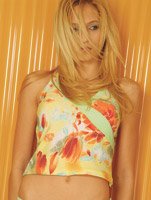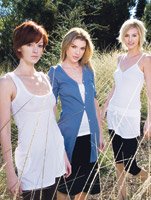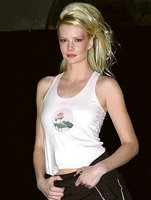Nature Calls
Wake up and smell the hemp: The eco-fiber trend is here, along with other ways apparel companies are working to save the planet.
It’s official: Green is the new black.
Clothing that is both stylish and supposedly good for the Earth is coming to a runway near you. Once considered the provenance of hemp shirts that felt like burlap bags and were sold alongside glass-blown water pipes and Jimi Hendrix posters, eco-friendly apparel is increasingly showing up in fashion-driven collections and has even gone so mainstream you can find it at Wal-Mart.
Al Gore as fashion icon? Maybe not, but the man’s legacy may prove to be less about his political career than his global-warming documentary, “An Inconvenient Truth.” Like any instigator of social change (or fashion trend, for that matter), the Oscar-winning film had perfect timing. The public was vaguely aware of damage to the environment but felt powerless to do anything. Now people feel that Earth’s destiny is in our own hands. Apparel and fabric manufacturers are rushing to unveil eco-friendly products, and consumers are willing to pay a surcharge if it helps sustain the environment.
Eco-friendly Fabrics
Los Angeles–based Ecotex has been on top of the green trend since 1990. A few years later it became the first U.S.-based company to offer a full collection of lycocell, a rayon-like fabric made from wood-pulp cellulose, which is marketed in the United States under the Lenzing-owned brand name Tencel. Tencel was the first natural, manmade eco-friendly fabric, says Ecotex CEO Raphael Javaheri. The fabric is biodegradable and during production goes through a solvent that is recycled rather than emitted into the atmosphere or water supply.
Since 1990, Ecotex has expanded its eco-fabric product line to include bamboo and organic cotton, which was first introduced in 1993. The fabrics are being embraced more than ever. “Since we began with Tencel, you have 15 years of evolution and information about global-warming issues,” says Javaheri. “People are more aware, and people want to do whatever they can. Maybe the Average Joe is unable to change his car or fuel, but he can at least buy an organic T-shirt.”
Ecotex’s organic cotton fabrics include some that are dyed with vegetable pigments before being turned into a yarn, rather than dyed with chemicals afterwards. Most Ecotex customers use the fabrics for T-shirts, yoga clothing, and bathrobes, though fabrics can be custom-made to fit any application, Javaheri says. The cotton is sourced mainly in the United States but spun in Turkey, India, and China, and runs 30 to 40 percent more than comparable non-organic cotton because of smaller production runs and greater farming costs.
Tencel and bamboo have wider applications, Javaheri says, and can be used for fine-gauge knits, intimate apparel, and men’s and women’s suits. Tencel is more expensive than linen, which it can be woven to replicate, in part because Tencel is classified as a manmade fabric and carries import duties of 70 percent, whereas linen is taxed at only 3 percent. Bamboo, whose inside is a pulp that can be turned into yarn for both knits and wovens, is also more of a specialty, luxury fabric. “You’re going to find bamboo in the contemporary market, not the mass market,” says Javaheri.
Unfortunately, Ecotex’s sales have declined since 2004, but that is mainly because of competition from China, Javaheri says, which is competing in the global market not just with low-end mass-market fabrics but higher-end alternative ones as well.
Recycling Initiatives
Everyone’s jumping on green’s alternative-fueled bandwagon, and even companies that don’t yet have green products are finding ways to make green a company policy. Eight-month-old, Los Angeles–based fabric maker Tresics is currently researching how to begin offering organic cotton products, but in the meantime it is looking at other ways of helping the environment. “With global warming and all the science pointing to chemicals, pollution, and environmental hazards for humans and animals,” says sales and marketing director Sam Paik, “we feel if we can’t yet bring in organic cotton we can at least start implementing protocols to start recycling. To implement that in the company, not only here but in our factories overseas, we’re making sure chemicals aren’t thrown out in a way that will lead to the ocean, and we even started repackaging boxes.”
Tresics’ marketing collateral emphasizes alternative energy, and Paik recently bought a hybrid car. “If everyone felt a little responsibility for the environment, it can make a difference,” he says. “I think that’s all it takes.”
Biodegradable Boon
Anything that can go green will go green, and if an organic zipper can be fashioned you can bet someone will start offering it.
For an already-on-the-market example of green on a small scale, look to fabric trim supplier John Solomon, a division of Mocksville, N.C.–based QST Industries, which in January released the Green Tearaway Washaway. It’s a water-soluble, biodegradable film backing for embroideries “that won’t hurt fishes when it goes down the drain,” says QST’s embroidery product manager Shane Rabineau, who works out of Los Angeles.
The film backing is the first of its kind on the market, Rabineau says, and the company has similar products already planned. “It just seemed like the right time, with all the global-warming talk, that we try to supply our customers with a product that’s eco-friendly,” says Rabineau. “A lot of our customers are moving to pesticide-free garment dyes and hemp fabrics.”
QST worked with a team of chemists to develop the product, and is the exclusive distributor for it. The film backing “costs a little more money, but customers are willing to pay more to help the planet.”
Fashion Focus
But consumers also want fashion, which they’re finally getting along with their contribution to the environment. “If you go back as little as five years, you saw a lot of boxy, shapeless, rough, boring fabrics and clothing,” says Lori Whyman of the Organic Trade Association, which has over 200 apparel or textile-based manufacturer members. “Now what you see are beautiful, well-fitting, exciting organic clothing.”
The United States actually lags behind Europe, especially Germany, in the promotion of organic clothing, Wyman says. But eco-friendly clothing may have extra appeal for a younger demographic that has grown up learning the importance of recycling and threats of global warming, Wyman says. “And a lot of younger people are familiar with buying online, and online purchasing is really the way to go if you want to shop for organic clothing.”
Wyman suggests starting your online search at Maggie’s, which operates the URL organicclothes.com.
And what are the benefits of going organic? “When you purchase a blanket made of organic wool, not only can you feel good about putting it next to your body, you can feel good about the way the animal was raised and the farmworkers that worked with the animals, and the land that was pristine.”
Ah, but how does that actually help the planet?
Wyman says organic raw-material farming does not employ pesticides. “Definitely it helps the planet because of water runoff,” she says. There’s also a new voluntary processing standard called the Global Organic Textile Standard, which offers guidelines including that organic-fabric processing use no heavy-metal dyes, no known carcinogenic substances, and that it encourage water conservation.
Reaching the Trade
The green apparel movement even has its own trade show—complete with a fashion show—devoted to “organic cotton, hemp, bamboo, recycled plastic, and other sustainable fabrics/products,” not to mention “ethically made and fair-traded products from around the globe.”
Developed by Howard Gabe, the Global ECO Trade Show debuted at the Venetian Hotel in Las Vegas during February’s edition of the MAGIC Marketplace. (ECO stands for Environmentally Conscious and Organic.)
Though attendance was modest, Gabe says feedback has been great, and he plans to make the show a twice-yearly event. “I had 20 exhibitors, and 20 exhibitors told me they want to come back to the next show,” he says, adding that attendee traffic was about 1,500. Exhibitors included Cape Fear Apparel, Toggery by Kate D’Arcy, Ugly Fish Clothing, Naturepedic, Avatar, Christian Rathbone, and Bliss Clothing.
As far as the green zeitgeist goes, Gabe says things heated up in the middle of last year when Wal-Mart revealed it was going to offer garments made of organic cotton. “That statement made retailers around the world say ’If Wal-Mart is doing it, then obviously the price point is okay,’” says Gabe. As for the consumer side of things, “Green awareness has finally hit its stride.”
Major Leagues
When a major fiber and fabric manufacturer such as DuPont enters the eco-friendly market, you know the trend is big. The company’s Sorona polymers, used to make everything from apparel to carpeting to automobile parts, typically relies on petrochemicals as its key ingredient. Now DuPont has developed Bio-PDO, a polymer made from corn sugar, a renewable resource.
In November 2006, DuPont began production at a new facility devoted to Bio-PDO, which consumes about 40 percent less energy than its petroleum-based counterpart and will save the equivalent of 10 million gallons of gasoline per year.
DuPont already has agreements with top apparel manufacturers; expect to see Bio-PDO products hit store shelves late this year.
Caveat Emptor
Though its applications may be more limited than those of organic cotton, bamboo is riding high on the eco-trend.
Terrence Chermak, for one, remains skeptical, and says that when it comes to bamboo, the public is being bamboozled.
The Los Angeles–based president of knit supplier Britannia Mills disputes the entire notion that bamboo is ecofriendly— or at least that it is more eco-friendly than the traditional natural fabrics cotton, wool, linen, and silk.
“It’s a false story that they’re generating,” Chermak, who specializes in wool and rayon, says of bamboo flag-wavers. First off, touting bamboo because it’s renewable is silly, because so are wool and cotton. True, bamboo may replenish itself more quickly, but that’s another matter.
As for bamboo’s novelty factor, bamboo is essentially rayon, Chermak says, which is how it is classified when imported into the United States. The term “rayon,” he points out, refers to any fabric made from plant cellulose. “Bamboo is just another raw material source to make rayon. But they get all excited because it’s new and grows fast and it’s cutting down a bamboo forest instead of a pine tree.”
What’s more, to transform bamboo’s plant cellulose into yarn, “You melt the stuff, which is done with super-harsh chemicals and a whole lot of energy, whatever the source is. And those things are not environmentally- friendly, I don’t care what anyone says.”
Organic wool is another foolish idea attempting to capitalize on the green trend, Chermak contends, “and is not a very nice process for the sheep.”
Wool, the oldest recovered swatch of which has been dated to 1,500 BC, is already environmentally friendly, he says. Sheep farmed for wool are given shots to prevent disease and are bathed with chemicals that repel insects. “They then spend 95 percent of their lives roaming free and eating whatever they feel like,” Chermak says. “The shots and baths are no different from what you and I get.”
Denying shots and flea-repelling treatments in the name of making “organic wool” will give the animals shorter and more miserable lives, he says. And what does it matter to the environment whether or not sheep get a shot? “It doesn’t help you or I, and it’s actually crueler to the animals because they’re going to get eaten up by bugs.
“Anytime there’s something new there’s a lot of hype,” adds Chermak. “Wool has always been ecofriendly, but no one’s banging its drum.”
Moreover, the processing of wool is less chemical intensive and more eco-friendly than melting down plastic bottles for recycled polyester. “But it’s better than throwing polyester away, so I give them a hell of a lot more credit than the bamboo people.”
The only thing permanent about fashion is that it’s always changing. And time will tell if eco-friendly represents a positive step toward a more enlightened civilization, or if it’s just another fashion trend that comes and goes like the changing of the leaves.
























